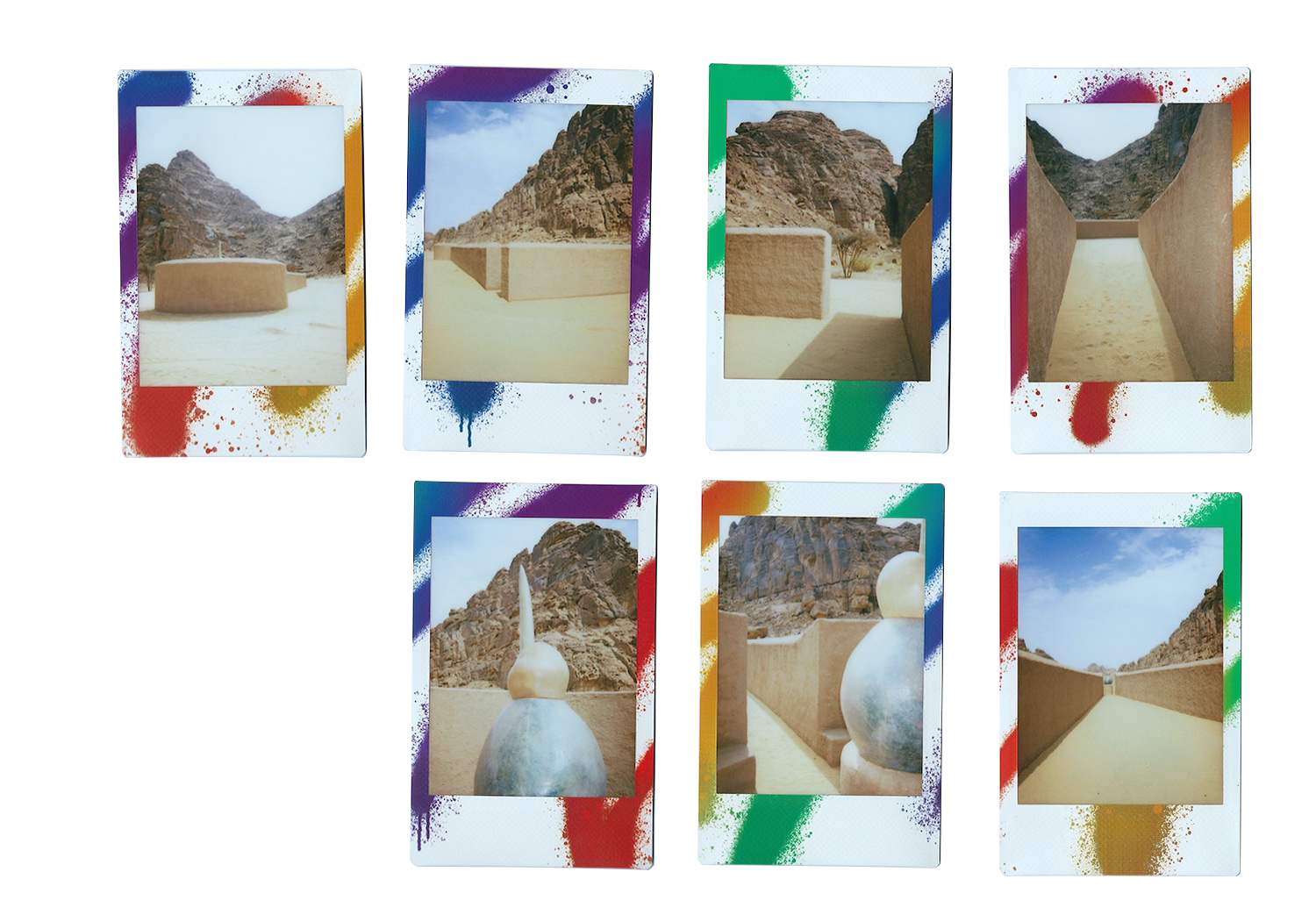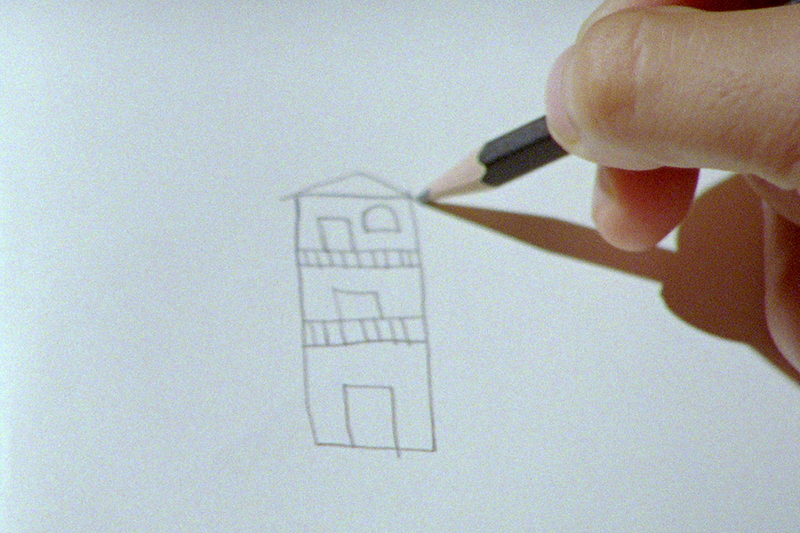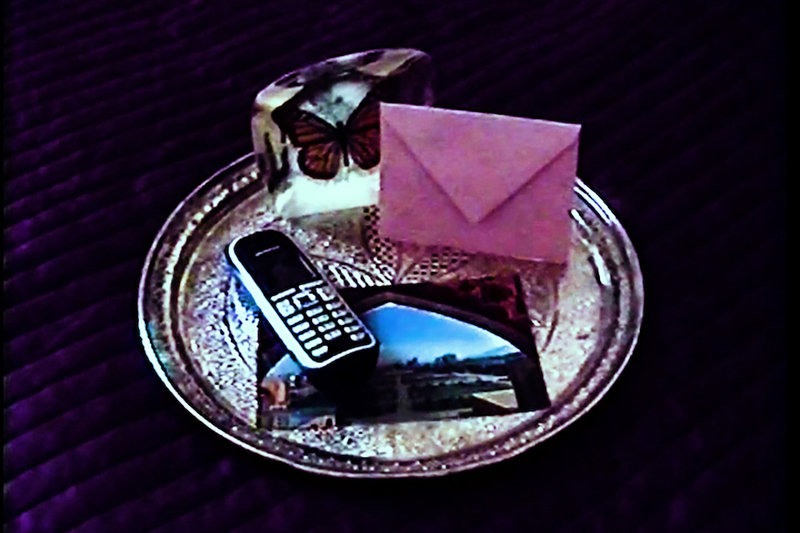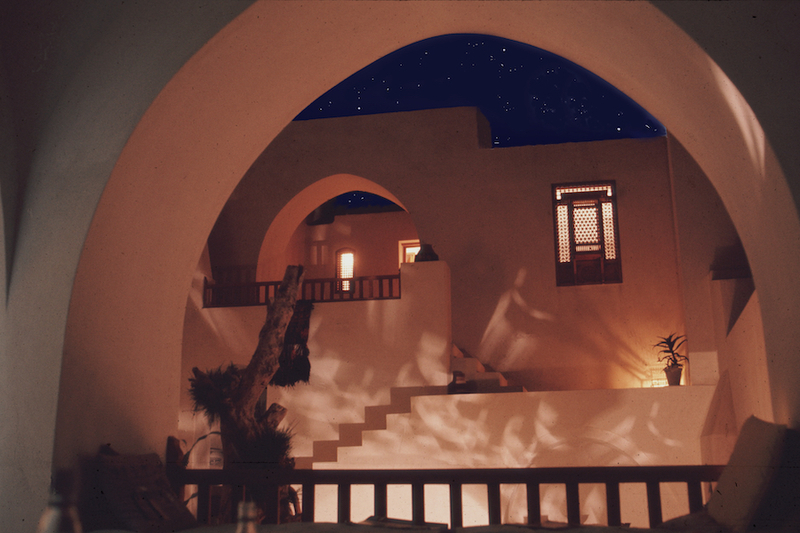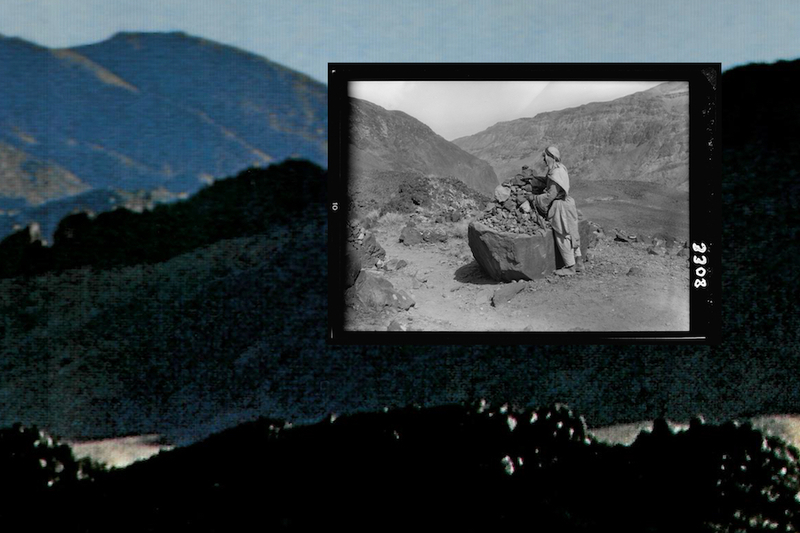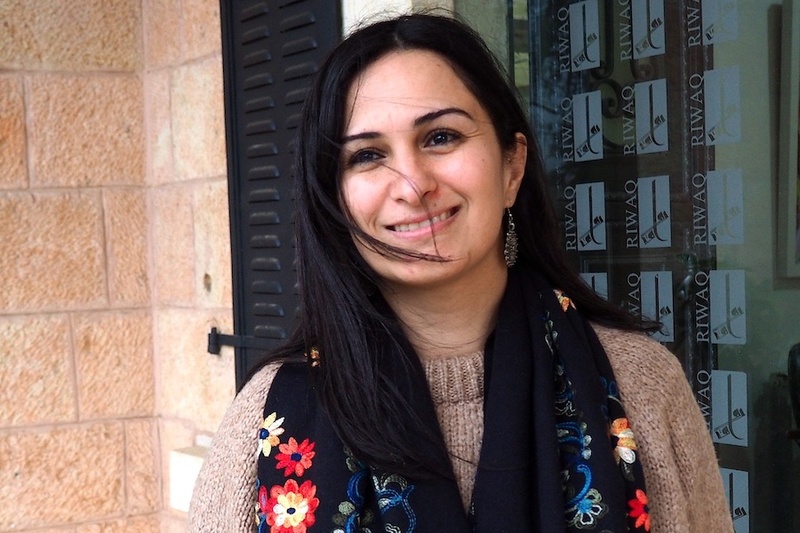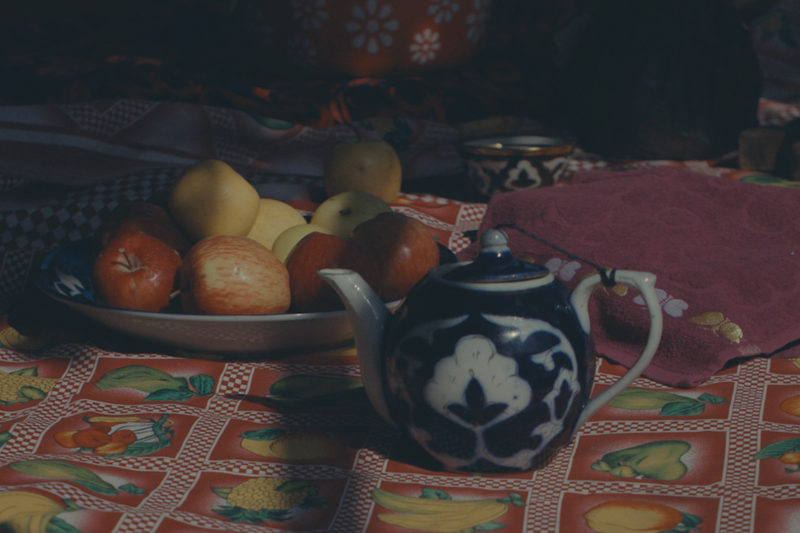AlUla, an ancient oasis city located in the Medina Province of Saudi Arabia, boasts a high concentration of precious artifacts, ancient stone inscriptions, rock dwellings, and tombs. Hafsa Alkhudairi offers an immersive set of disparate narratives that collectively form a holistic view of her home.
Walking through AlUla, one may feel at times that the place is not real. Yet, the feeling is lost the moment you touch the textures of the land: the softness of the sand, the fuzziness of the greenery, the furriness of the camels, and the roughness of the mud buildings. However, the question of realness can be constantly explored while driving, hiking through the mountains, meditating above the volcanic rocks in Harat, picnicking in the farms, and strolling in the old town. Being in AlUla and living there is almost otherworldly.
AlUla’s history enhances its otherworldliness. The Nabatean? Dadanites? Lihyanites? They immortalized their stories by carving their writings, graves, and art into the mountains. Hegra shows the work of people who meticulously created spaces to commemorate their dead and their love for their loved ones. Dadan shows us the role of safeguarding the dead with beautiful and maybe a bit conceptual lions that overlook and protect their royals. The graves outlived their empires; only their stone buildings were left in ruins. Their mud buildings didn’t last. Yet, most of their stories did, hidden between the rubble.
However, the people of AlUla are consistent. Although the homes are mud-based, the monuments they wanted to preserve were made of stone. Still, the mud-based buildings seemed more romantic. They held many people’s attention, questioning how people lived and led their lives, especially when the people in the old settlement left it for new concrete buildings as recently as the past 50 years.
These living conditions raise the question:
One can feel the roughness of mud-based buildings by gently running a hand against them, and there is always the temptation to do so. The feeling of walking between the houses and farms is an unmitigated joy and wonder. They have withstood so much and are resilient, yet most of our collective memory indicates that mud is malleable.
So, what has made these structures so resilient? It is in the method of creation. The mud was fermented and built over time and constantly refreshed to ensure enough was available, especially during times of intense construction. A pool was created in the land where the water and sand are fermented. People would go inside and mix with their legs, ensuring the quality and consistency of the mud. The pool was left for ten days minimum before use. Then, the material would be tested to ensure it would not fall apart.
If the mud was ready to use, the builders would mix the mud from the fermented circle with straw and place it in a wooden mold. The mud brick would then be cleanly shaped and placed in the sun to harden. The bricks would be placed on each other, and mud used to secure the pieces together. After the building was done, it would be reinforced by round earth, which is another way the ancient settlements used to be built before the brick method. The process involves slapping the fermented mud without straw onto the building in order to produce the finishing touches. This is also how the old buildings in the oasis and the settlements were constructed. Finally, as a last step, some houses have evidence of painted decorations, showcasing the love of art the lands have enjoyed decades before the current evolution and preservation efforts have taken place.
The process of restoration is a constant practice in such areas, conducted to ensure the building quality. As the saying goes, roughly translated, “if you have a crack lengthwise, build castles. If you have a crack widthwise, lead it to the ground.”
“لو جاك الشق بالطول، ابني عليه القصور
لو جاك الشق بالعرض، هدّه للأرض"
To understand the importance of this restoration, we should have a walk through the oasis, a spatial experience.
Places like Daimoumah allow one to walk through history and nature simultaneously, but the true experience is getting lost in the pathways between buildings. Domestic and wild animals, trees, bushes, fruits, vegetables, and other non-human species all live together under the loving hands of the farmers, showing the diversity of life and the care they have for the beings within their lands.
After breakfast at Pink Camel, walking sounds like the perfect plan. The path is usually taken with a bottle of water and leads down the Orange Path towards a small pathway. From an open landscape to an enclosed one, the path takes the adventurer through palm trees toward several buildings under restoration. The restorers are professional archeologists and are friendly; they will tell you the story of the mud-based buildings.
Past the restorers, many end up on pathways filled with the residue of the beautiful plants, each step producing a cacophony of sounds from cracking twigs and leaves, dates falling to the ground, chirps of songbirds, and the breeze rifling between people’s clothes. There is life beyond the expected in these areas and they make their voices heard. Moving from the sounds of the oasis into one of the buildings is an entry into a moment of silence.

These summer houses offer refuge from the glaring and burning heat of the summer for humans and non-humans alike. The existence of these homes reminds us of the kind of care that many of us forget about in the hustle and bustle of city life. The care for ourselves exists through our care for other living beings and histories they may hold in their cells.
To understand further the stories of these buildings is to cross over the road from the summer settlements and into the warmth of the winter ones to speak with the Old Town and its keeper of stories.
Based on a conversation with “Ahmad Alimam,” AlUla’s son and storyteller:
The history of AlUla does not start and end with the Old Town that we know of now. AlUla used to be called “Umm AlQura”, Mother of Villages, and spanned six or seven villages from Hijr to Al Marwah. Each village was as strong as the buying power of the people that passed by and were accommodated. So the villages rose and fell, leaving AlUla as the name of the area instead of a singular place. This empowered the elders to immortalize their names on the walls of the mountains surrounding the main village, ensuring the place of their descendants for generations to come. Yet, they did not build their homes from stone, with the exception of a few places in the Main Street, which they took from different areas, possibly Dadan. But that is not what makes the old town fascinating and the area explorable.
What is the most interesting aspect of mud-based old settlements like the one in AlUla? They are both ancient and very new. Mud buildings usually need high levels of maintenance and so, the buildings have their parts renewed, such as the logs from which the roofs are constructed or the walls when they need to be replaced.

The second most fascinating? The way the full settlement was built. The first building is the fort. The homes were built around it organically, ensuring the entrances weren’t directly accessible from the main passages, confusing those unfamiliar with the town. Coming into the settlement from the Main Street, you would have to be familiar with the passages to get from one area to another.
In one anecdote, one of the nearby tribes from the Hail region sends a spy into AlUla, the different settlers decide to confuse him. They give him a tour, leading him to the different leaders within their community. However, they aren't direct with their tours; they take the spy on a veritable wild-goose chase, giving their men time to switch clothes and act as though they themselves are members of the families he is meeting. Their acts make the spies overestimate the number of capable warriors protecting the settlement.
This story is just one of many that represent the maze-like existence of AlUla’s Old Town. The “Saqifa” is another example. Saqifa is a bridge-like space that is built between two homes. This is usually created for newlyweds but can be for multiple purposes, such as storage. The name of this piece of structure is usually attributed to the neighbor’s last name, as long as they consent to it. These structural elements create the illusion of repeated pathways. Another example is the lack of straight roads. The twists and turns lead down dead ends.
Yet, there is still a feeling of community and companionship, despite some of the normal disagreements between families and the variety of people from all over the world that settled there. The experience of AlUla’s Old Town is a feeling of being lost then found, both figuratively and literally. One can get lost in the experience of the winding streets of the old mud-brick buildings reflecting a mental state of being lost in a foreign land, not easily knowing how one can get out. But finding that light at the end of the tunnel, or winding roads, shows the importance of knowing the secrets of both the mental and physical land to find oneself deeply and truly.
Commissioned by the Royal Commission of AlUla for Desert X AlUla 2022
Winter morning in a soft breeze is my first conceivable memory. I remember being made from mud and built around a steel structure. A variety of hands, soft and rough, all contribute to my creation: it is a communal effort. I exist as a production of love and labor. Yet, my first memory is of that beautiful breeze.
From a bird's eye perspective, I look like a keyhole with a dot in the middle of my rounded head. But I am an ancient structure that was meant to trap animals. How? The dot is usually where water and food would be placed to lure animals in, but because of my unique composition, most animals would not be able to see the exit, and my back wall obscures the side entry. Now, the animals I trap are humans, lured in by the promise of cooler weather and treasures inside my resin sculpture: the dot in the bird’s eye view.
My mythology does not end in my history but is pushed forward by my sculpture. Gathering stories from Hegra, my sculpture stands on a mudbrick basin, and inside it, immortalized are visual representations of monsters or animals that also exist in the tombs. These creatures are both easy to see and hard to comprehend as they bear the understanding that multiple people and cultures have passed by AlUla and these ancient lands.
If you stand in my seating area, you won’t see anything other than a gorgeous view. I present everything around you as you look above my frame. My visitors are isolated within me. They have a moment where it is just them, the view, and me.
All images provided by Hafsa Alkhudairi. All rights reserved.
